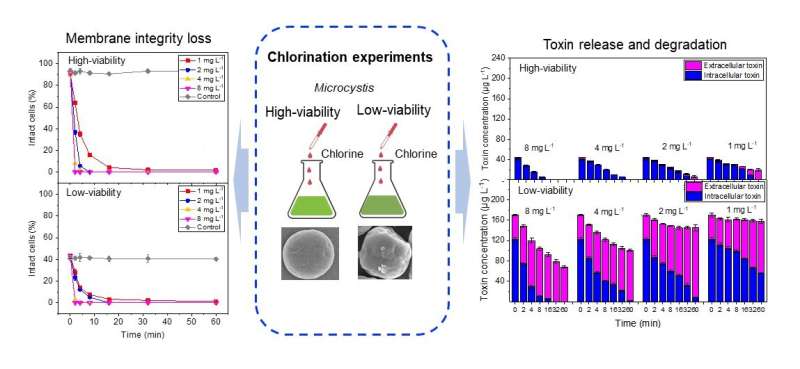Study highlights differences of chlorination to treat high- and low-viability cyanobacteria

Lakes and reservoirs are important sources of drinking water, but the high frequency of toxic cyanobacteria bloom and associated cyanotoxin could impair drinking water quality. In recent years, major studies have investigated the effects of chlorination on membrane integrity and toxin fate of high-viability cyanobacteria.
According to a research conducted by Tang et al. in 2018, cyanobacteria bloom is a successive process in natural freshwaters including development, maintenance and decline stages. They found gene expression of nitrogen and phosphorus metabolism were down-regulated at the decay stage, suggesting that nutritional limits may cause a decrease of cell viability. However, whether the change of cell viability could affect chlorination was unclear.
To investigate this issue, a typical toxic cyanobacteria (Microcystis aeruginosa FACHB—915) was used as experimental material by researchers from the Institute of Urban Environment (IUE) of the Chinese Academy of Sciences (CAS). High- and low-viability cells were collected to conduct chlorination experiments.
Results showed chlorine exposure was lower for low-viability cells than high-viability cells with the same initial chlorine dosage, but low-viability cells were less resistant to chlorination, leading to higher rate of membrane damage and intracellular toxin release.
For high-viability cells, there was no increase of extracellular toxin with sufficient chlorine exposure whereas it showed a continuous increase for low-viability cells mainly due to its lower rate of extracellular toxin degradation than intracellular toxin release.
Additionally, the total toxin could be completely oxidized for high-viability cells with sufficient chlorine exposure (>30 mg min L-1) whereas chlorination could not work well for low-viability cells even with chlorine exposure of as high as 36 mg min L-1.
This study was the first report to demonstrate chlorination may not be a feasible option to treat low-viability cyanobacteria during decline stage of cyanobacterial blooms, providing an important reference for the application of chlorination in DWTPs.
These results have recently published in Water Research.
More information: Xi Li et al. Comparing the effects of chlorination on membrane integrity and toxin fate of high- and low-viability cyanobacteria, Water Research (2020). DOI: 10.1016/j.watres.2020.115769
Provided by Chinese Academy of Sciences


















